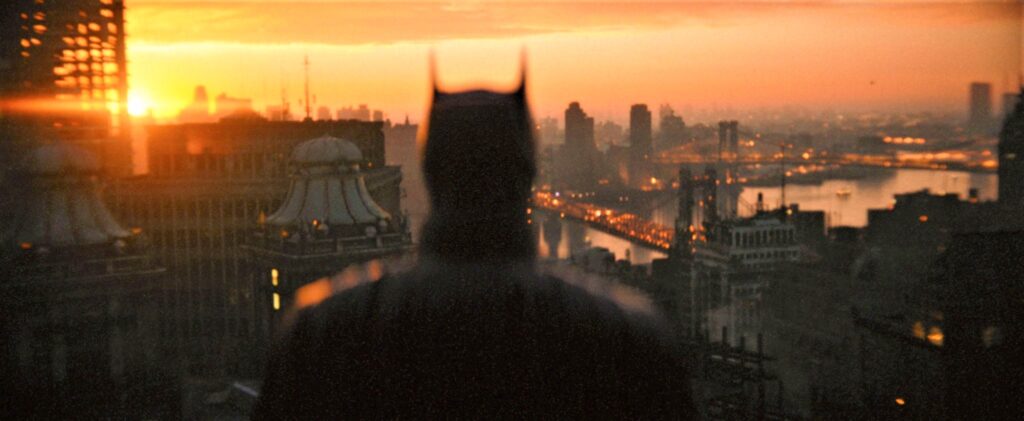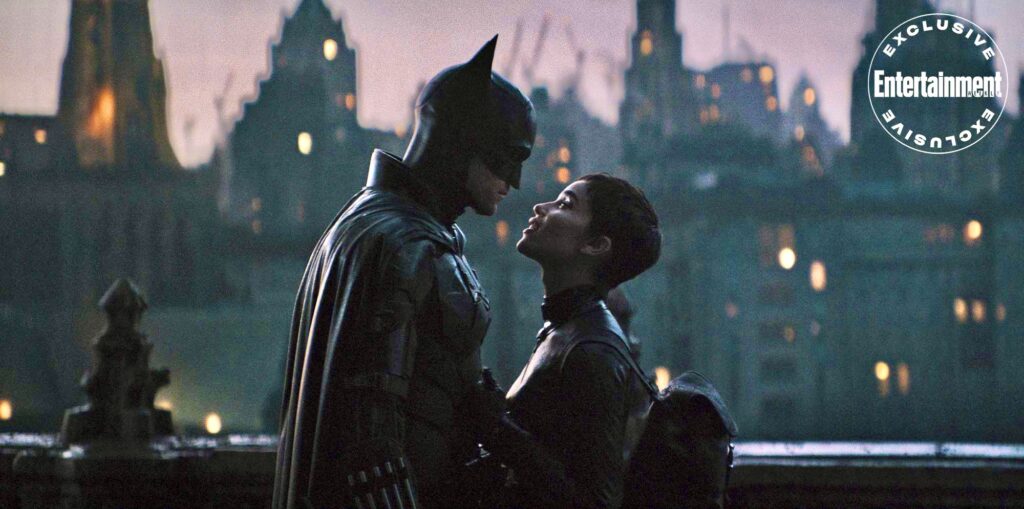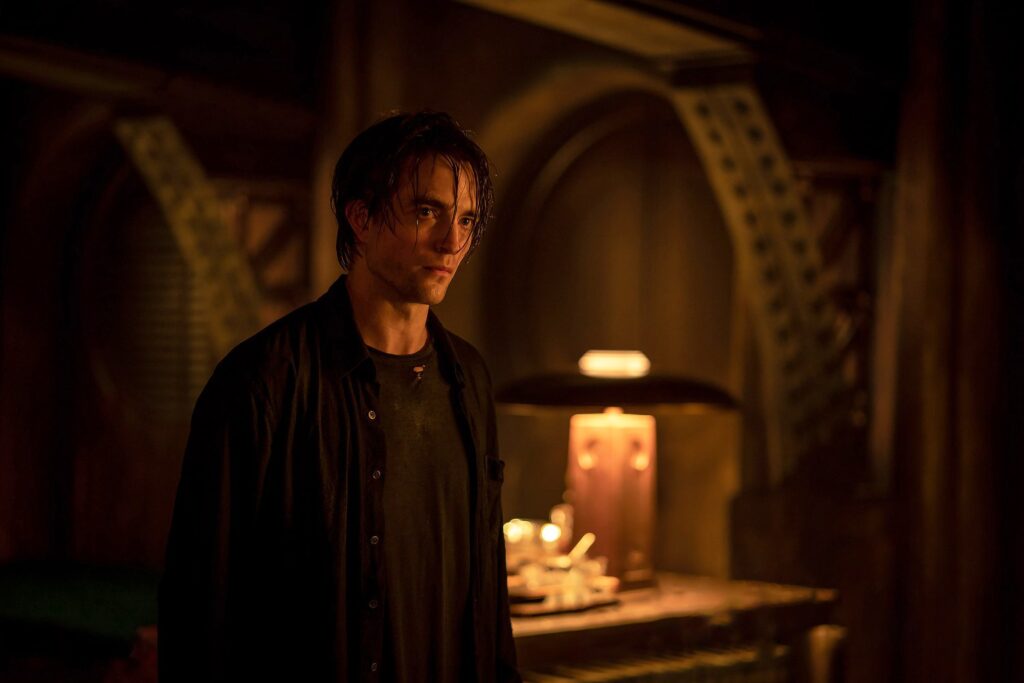The Batman (2022)

DIRECTOR: Matt Reeves
CAST: Robert Pattinson, Zoe Kravitz, Paul Dano, Jeffrey Wright, Andy Serkis, Colin Farrell, John Turturro, Peter Sarsgaard
REVIEW:
With the simply-titled The Batman, Matt Reeves (Dawn of the Planet of the Apes) has become only the second filmmaker—following Christopher Nolan’s acclaimed Dark Knight trilogy and the more recent misfires of Zack Snyder’s Batman v Superman and Justice League—to get a live-action Batman movie right. In fact, this might be the most “Batman” of any live-action Batman movie thus far, and like Nolan’s trilogy, it’s a stand-alone reboot doing its own thing unconnected to the DC Expanded Universe. It’s also the darkest, most adult-oriented Batman movie yet—surpassing the seriousness of Nolan’s vision—and an unconventional comic book movie. Essentially a serial killer/murder mystery/detective story with superhero and comic book elements that often resembles David Fincher’s Se7en more than a typical comic book flick, The Batman shows no lightening of the darkness in which onscreen incarnations of its title character are steeped.
Perhaps it’s to avoid rehashing stuff we’ve seen before, but Reeves isn’t interested in an “origin story”. We unceremoniously jump straight into the plot with a Bruce Wayne (Robert Pattinson) who’s already Batman—albeit still a fledgling one—and while the legacy of the Waynes looms large over the proceedings, there’s no obligatory flashback to their murder that often seems inevitable in a Batman franchise. In Reeves’ universe, this exceptionally troubled iteration of orphaned billionaire heir Bruce Wayne has been secretly moonlighting as the caped-and-cowled vigilante for two years, but he’s having a hard time making much headway against Gotham City’s rampant crime and systemic corruption, and he’s about to face a bigger problem. A mysterious serial killer known only as The Riddler (Paul Dano), is targeting some of Gotham’s most prominent—and corrupt—officials and leaving riddles and clues addressed to Batman himself at the scenes of his grisly crimes, drawing Batman into a cat-and-mouse game that will test both his brains and brawn. Armed with few allies beyond his loyal butler Alfred (Andy Serkis) and stalwart cop Jim Gordon (Jeffrey Wright), Batman’s investigation will lead him deep into Gotham’s seedy underbelly and uncover a web of corruption that might hit a little too close to home and involves various city officials, as well as mob kingpin Carmine Falcone (John Turturro) and his lieutenant Oswald “The Penguin” Cobblepot (an unrecognizable Colin Farrell). Along the way, Batman forms an uneasy team-up with nightclub waitress Selina Kyle (Zoe Kravitz), who’s got her own agenda, along with a knack for breaking-and-entering and a thing for cats.
More so than The Dark Knight—which was hailed as breaking the mold of what’s expected from the genre—The Batman is not a conventional comic book superhero movie. It’s firmly adult-oriented and may be disturbing—not to mention overly dense and complicated—for young children. There’s only really two “major” action sequences, a car chase with Batman pursuing The Penguin that results in vehicular mayhem, and the climactic battle, along with sporadic smaller bursts including a few brawls with thugs and henchmen and Batman making a high-flying escape from police headquarters. The rainy car chase gets a little confusing to follow, but Reeves has a better grasp of hand-to-hand fight choreography than Christopher Nolan (in fact, two scenes, one a brawl with goons in a nightclub, and a blacked-out hallway fight in which Batman is only visible in flashes of gunfire, recall better-choreographed versions of similar scenes in The Dark Knight and The Dark Knight Rises). Overall, however, the emphasis is less on elaborate action sequences than on detecting, analyzing ciphers, answering riddles, and following a detective investigation involving neo-noir staples like an ambiguous femme fatale and a rogues gallery of shady characters. Compared to Reeves, Nolan’s films (hailed as “dark and serious”) seem almost lighthearted at times. There’s precious little comic relief in Reeves’ take apart from a couple low-key instances, like the identical twin nightclub bouncers (real-life twins Charlie and Max Carver) Batman keeps running into. The formidable nearly three hour runtime and slow pace might be alienating for some viewers expecting something more action-oriented, and the complex storyline juggles enough characters and subplots that there are times when the hunt for The Riddler moves—momentarily— to the backburner.

Reeves takes gritty pseudo-realism to a level that surpasses even Nolan’s series for which “realism” was a key word, without giving up a David Fincher-esque stylization (his Gotham City is much more atmospheric than Nolan’s). This Batman has a DIY, homemade vibe—no Morgan Freeman conveniently onhand to hook him up with high-tech gadgets—and the “Batmobile” isn’t the military tank-like Tumbler of Nolan’s series, but a muscle car with a souped up engine and a battering ram of a front. Likewise, this version of The Riddler is far removed from the zany, flamboyant likes of Jim Carrey or Frank Gorshin before him. No garish costumes or question mark-shaped canes for him; he’s been revamped into a diabolical serial killer who recalls Se7en‘s John Doe, the Jigsaw villain of the Saw franchise, or the real-life Zodiac Killer (whom the filmmakers openly used as an influence) more than any previous version of the character. More than even Christian Bale’s or Michael Keaton’s, Pattinson’s Batman is legitimately menacing, an ominous figure who stalks criminals like prey, an impression accentuated by the sound design that gives his footsteps a reverberating thud, like the hammers of doom. And while the movie honors Batman’s “no kill” rule (which both Keaton and Ben Affleck’s Batmans freely threw to the wind), he quickly establishes that he doesn’t shy away from delivering brutal beatdowns. And Pattinson isn’t your typical debonair Bruce Wayne either; he’s a recluse who skulks around the Batcave (here seemingly an abandoned subway station) and gothic Wayne Tower (a tower in the city rather than a country manor in this version) who has no interest in putting on the suave playboy act, with only Alfred for company, and even they have a strained relationship as Alfred is dismayed by Bruce’s self-destructive and obsessive tendencies. He only cleans up once, for a rare public appearance; the rest of the time his hair is messy and disheveled and black eye shadow runs down his face, at times recalling Brandon Lee’s The Crow (ironically, Pattinson had a more typical “Bruce Wayne” look in Christopher Nolan’s Tenet than he does here). Selina Kyle is only a fledgling “Catwoman” and is never referred to as such, although there’s room for her to grow further into her alter ego if she returns in a potential sequel. There’s a heavy neo-noir vibe to the proceedings that recalls vintage David Fincher. While by all indications the action takes place in present day—we use cell phones and livestreams and laptops—the police uniforms have an intentionally old-fashioned, retro vibe, helping give Gotham City a timeless feel. Reeves delights in stocking the movie with noir types—Gordon as the world-weary detective, Selina as the morally ambiguous femme fatale/love interest with her own agenda, and Falcone and Penguin supplying the requisite sleazy gangsters—and Bruce bookends the film with a pulpy voiceover narration that could be straight off the pages of Frank Miller’s Batman: Year One graphic novel.
While he’s not afraid to put a less traditional, less conventional spin on some characters (most significantly The Riddler) and other elements, Reeves comes onboard as an avowed Batman fan with a passion for the source material, and it shows, as he draws inspiration from multiple eras of Batman’s long comic history. Batman comics aficionados will recognize The Long Halloween, Year One, and Zero Year among perhaps the heaviest influences (Falcone gets a monologue ripped straight off the page of The Long Halloween), but references to up to half a dozen comics storylines can be picked out by the well-versed, along with a few Easter Eggs and possible foreshadowing name drops that only Batman comics fans will pick up on. Reeves even directly references Batman’s original inspiration by having another character sarcastically address him as “Zorro”. Selina’s physical appearance recalls Batman: Year One while taking some elements of her backstory from The Long Halloween, and the use of The Riddler as the main villain and aspects of his plans recall Zero Year. The depiction of Gotham City is the best of any live-action Batman movie thus far. Tim Burton and Joel Schumacher’s Gotham was overly cartoonish. Christopher Nolan went to the opposite extreme, toning it down into a generic “big city” lacking atmosphere. Reeves hits the sweet spot, not only avoiding making his Gotham overly recognizable as any one real location—filming took place in London, Glasgow, and Chicago, as well as elaborate indoor sets—but bringing it vividly to life as a sprawling, rain-drenched, decaying urban metropolis where the crime and corruption is palpable and we can believe a Batman stalks the streets, accentuated by Greig Fraser’s cinematography (at times, the dystopia recalls Blade Runner‘s dilapidated Los Angeles). This isn’t the same decaying, dilapidated Gotham as Todd Phillips’ Joker, but it feels like it could be. The combination of a montage of Gotham’s crime and dilapidation overlaid with Bruce’s noirish narration weaves an immersive spell right off the bat; it’s as if Year One has been brought straight from the page onto the screen. Reeves also doesn’t shy away from some timely social commentary. Apart from obvious themes of class issues and political corruption (which are pretty much always timely), the term “white privilege” is explicitly dropped, The Riddler assembles a cult following via a QAnon-esque conspiracy theory website (aspects of his final plans might be uncomfortably similar to some recent domestic terrorist attacks), and Batman is introduced interrupting an assault on an Asian man.
Reeves also avoids the trap of predictability. At one point, the movie looks to be observing the oft-seen cliche of the “villain who intentionally gets himself caught only to escape at will” (a plot development that happened in Nolan’s trilogy twice), but things don’t play out quite the way we think, and the final action sequence is a little different from what we expect by not involving a final confrontation between the hero and the main villain. Also, viewers accustomed to a scenario where the hero narrowly thwarts an evil scheme and saves the day in the nick of time who were surprised when Batman didn’t save Rachel in The Dark Knight might be in for a similar surprise here (the situation is very different, but the subverting of expectations is in the same vein). There’s misdirections and red herrings and surprise revelations, and at times exactly which character qualifies as the “big bad” is a matter of interpretation. Without getting into spoiler territory, The Riddler’s got an axe to grind and a specific agenda, and his motivation—when it’s eventually revealed—isn’t exactly what we might expect from a typical comic book villain (he’s less a cackling megalomaniac than a deeply damaged and deeply disturbed misanthrope).

Of the assembled cast, Robert Pattinson is arguably the marginally least successful. As Batman, he’s just about perfect; he looks great in the Batsuit and has a surprisingly intimidating presence, and he speaks in a gravelly whisper that’s mercifully more subdued than Christian Bale’s infamous Batman voice. It’s a little harder to judge his interpretation of Bruce Wayne. His Bruce is written as a sullen, withdrawn recluse, but Pattinson’s performance is a little too one-note. In an inversion of most Batman actors, Pattinson is more animated as Batman than as Bruce Wayne, where he runs a little too close to the one-note dreary moping of Twilight‘s Edward Cullen (in this regard, his version is arguably a slight spiritual cousin of Michael Keaton, who also played Bruce as a neurotic introvert who comes to life when the Batsignal lights up). Pattinson is a better fit for the role than Ben Affleck, but Christian Bale’s performance had more depth and felt better-rounded (though Bale had a whole trilogy while this is Pattinson’s introductory outing, so there’s room to grow).

Pattinson is backed up by a solid cast ensemble doing sterling jobs in limited but important roles. A couple of the actors are underused—most notably Andy Serkis and Colin Farrell—but that’s the nature of the beast. Zoe Kravitz plays Selina Kyle with the right mixture of slinky sexiness, attitude, and ambiguity, and generates a little sexual tension with Pattinson, even though they never come fully “face-to-face” (this technically isn’t the first time Kravitz has played Catwoman; she previously voiced the character in The Lego Batman Movie). Top-tier character actors like Jeffrey Wright, Andy Serkis, and John Turturro bring quiet gravitas to the smaller but key roles of Batman’s two allies Gordon and Alfred and mob kingpin Falcone. Jeffrey Wright has no trouble essaying Gordon’s world-weary but dutiful demeanor as he essentially plays the Watson to Batman’s Sherlock. John Turturro’s Carmine Falcone is lower-key and less scenery-chewing than Tom Wilkinson’s in Batman Begins (Turturro plays him as an old-school mobster type who’d be at home in The Godfather), but Turturro imbues his outwardly amiable demeanor with a low-key veiled menace. Andy Serkis, an unconventional casting choice for Alfred (who squeezed in his handful of scenes here while simultaneously directing another comic book movie, Venom: Let There Be Carnage), plays a less elderly version of the butler who’s more gruff and less openly warm than the likes of Michael Gough or Michael Caine (insofar as he recalls any previous Alfred, he’s closest to Sean Pertwee’s unconventionally bad-ass Alfred on the Gotham television series). Serkis’ Alfred is interestingly “different”; too bad his few scenes don’t let us get a better “feel” for him (a later scene might have had more effect if this Bruce and Alfred’s relationship was better-established). An unrecognizable Colin Farrell gets to do a little hammy scenery-chewing as The Penguin, but he doesn’t get a lot of screentime (although there’s bigger plans for his character down the road, including his own HBO Max spin-off miniseries) and Farrell is so buried under makeup, prosthetics, and padding that casual viewers might not know he’s in the movie until the end credits. Even Gary Oldman as Winston Churchill in Darkest Hour was more recognizable. Last but not least is a chilling Paul Dano, whose Riddler is masked for most of the movie and, when his face is eventually revealed, is physically unimpressive and deceptively innocuous-looking. Dano’s Riddler might not be quite as diabolical and demented as Heath Ledger’s Joker in The Dark Knight, but he’s a runner-up. In small roles, we have Peter Sarsgaard as the shifty District Attorney (not named Harvey Dent), and newcomer Jayme Lawson as a vaguely Alexandria Ocasio-Cortez-esque political candidate.
While there’s a lot to appreciate about The Batman, it’s not perfect. It’s hard to deny that it runs a bit too long and the pacing is uneven; after a strong start, it drags in sections. One gets the feeling it could have benefited from tighter editing and some judicious pruning of some scenes that are extraneous or run too long. There’s times when the plotting feels a little messy and the resolution of The Riddler’s maze feels slightly underwhelming after the convoluted set-up. By the time things finally wrap up, it feels as long as The Return of the King with as many endings-upon-endings. With a slower pace and a lower action quotient than your average comic book superhero movie, it won’t be what everyone is expecting flocking to the theater for a Batman movie, and might prove divisive. But for Batman fans, it represents a welcome return to cinematic respectability after Zack Snyder’s misstep, arguably the best Batman movie since The Dark Knight, and arguably the most comic accurate live-action Batman movie yet brought to the screen. While slightly unwieldy in some respects, it’s good enough to warrant hoping this cast and crew return to Gotham City.
* * *